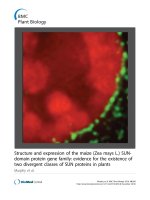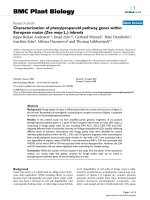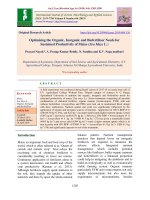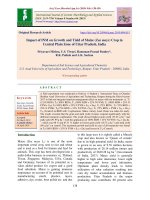Determination of crop phenological phase based on leaf number and net photosynthetic rate in six maize (Zea mays L.) Hybrids
Bạn đang xem bản rút gọn của tài liệu. Xem và tải ngay bản đầy đủ của tài liệu tại đây (270.5 KB, 7 trang )
Int.J.Curr.Microbiol.App.Sci (2019) 8(9): 2887- 2893
International Journal of Current Microbiology and Applied Sciences
ISSN: 2319-7706 Volume 8 Number 09 (2019)
Journal homepage:
Original Research Article
/>
Determination of Crop Phenological Phase Based on Leaf Number and Net
Photosynthetic Rate in Six Maize (Zea mays L.) Hybrids
M. Ravi Babu*, K. L. Narasimharao, Y. Ashoka Rani,
M. Martinluther and P. R. K. Prasad
Department of Crop Physiology Agricultural college ANGRAU Bapatla 522101, India
*Corresponding author
ABSTRACT
Keywords
Photosynthetic,
reproductive
growth, vegetative
development
Article Info
Accepted:
25 August 2019
Available Online:
10 September 2019
A field experiment was conducted to study the determination of crop age
based on leaf number and photosynthetic rate was under taken at the
Agricultural College farm, Bapatla duringrabi 2016-17. The experiment
was laid out in randomized block design with six maize hybrids as
treatments in four replications. The stage at which the reproductive growth
was attained in all maize hybrids, based on number of leaves expanded on
the stem at 42DAS, vary among hybrids differently. Pinnacle (V12-12.50),
DKC9142 (V12-12.25), DKC 9042 (V12-12.00), 900MGOLD (V11-11.75)
and DKC 9081 (V11-11.50).The hybrids DKC 9142 (36.35) and Pinnacle
(36.30) continued its dominance of significance in net photosynthetic rate
till 63DAS. However, the maximum net photosynthetic rate was recorded
among all maize hybrids during crop growth period at 70DAS ranged from
37.80 to 39.95 but all hybrids are at a par in Pn values.
the physiological age of crop is more useful
for crop improvement programmes.
Introduction
Maize is the world’s third most important
cereal crop after wheat and rice. The maize
production in India about 22 million tonnes
with an area of 9.2 million hectare. Several
experiments were conducted to determine the
growth stages of maize in a given
environment. But, the basis for the variation in
dry matter production and reproductive
growth in relation to its foliage is less
understood. The leaf growth that designates
Leaf development, represented by the
appearance and accumulation of leaves is an
important part of the vegetative development
of agricultural crops. In maize, leaf
development starts at emergence and ends
with the appearance and expansion of the flag
leaf, when the final leaf number (FLN) is
defined. In maize crop the vegetative
development overlaps the reproductive one.
2887
Int.J.Curr.Microbiol.App.Sci (2019) 8(9): 2887- 2893
Therefore, leaf number (LN) is related to some
reproductive developmental stages, such as
ears and tassel initiation (Forsthofer et al.,
2004). As leaf number increases, crop leaf
area index (LAI) for net photosynthesis and
crop biomass production (dry matter) also
increases. Application of nutrients in maize is
also related to leaf number (LN), being
recommended at V4 (four expanded leaves),
V7 (seven expanded leaves), and V11 (eleven
expanded leaves) (Forsthofer et al., 2004).
Thus any management practice or biotic or
abiotic stresses that effect the leaf
development may potentially impact the
reproductive growth and development and
ultimately influence the crop yield.
Photosynthetic CO2 fixation by plants
responds immediately to fluctuations in the
density of the photosynthetic photon flux (Q),
such that the gain of dry mass is closely
related to the light utilization ability of plants.
This ability, in turn, depends primarily on the
leaf area index (LAI) and also the arrangement
of leaves in the canopy, the morphology and
anatomy of leaves, the sun elevation, changes
in the quality or spectral distribution and the
multiple reflection of Q within the canopy
(Bavec and Bavec, 2002; Montpied et al.,
2009; Nobel et al., 1993; Patakas et al., 2003;
Stewart et al., 2003). According to Nobel et
al., (1993), the flux density of photons
reaching each level in the crop canopy is
considered to be the main factor determining
the rate of CO2 assimilation by individual
leaves. It has been suggested that, to
understand the contribution of each leaf
individually for photosynthesis, the overall
foliage canopy must be considered with regard
to the variability of Q penetrating the
vegetation layers. It is known that when Q
penetrates the
canopy, it
decreases
approximately exponentially depending on the
number of leaves (Hirose, 2005). Therefore,
the overall photosynthesis of a plant
community depends on both the Q absorbed
by the leaf canopy and also on its distribution
in the culture profile (Montpied et al., 2009;
Nobel et al., 1993).
Materials and Methods
The field experiment was laid out in
randomized block design with six maize
hybrids i.e.900MGOLD, V2-DKC 9142, V3DKC 9120,V4 - DKC 9081, V5 - DKC9042
and V6 - Pinnacle treatments in four
replications at Agricultural College Farm,
Bapatla during rabi season of 2016-2017.The
details of material used and the methodologies
followed during the course of investigation are
presented here. Total number of leaves per
plant was determined by tagging the 5th leaf of
five plants per plot at 14 DAS before the
germination
leaves
senesced.
When
senescence had progressed, the tagged were
adjusted to10th leaf. Total number of leaves
were counted from 7DAS to anthesis while
number of green leaves were counted up to
physiological maturity. The number of leaves
are counted based on the physical appearance
and leaf tip emergence of the plant at every
day observation for counting the leaf number
index in relation to the age of the plant.
Leaf appearance rate was calculated on leaf tip
(LN Tip) and on expanded leaf (LN expn)
basis. A leaf was assumed expanded when
ligule is visible.
The accumulated leaf number (LN) was
calculated starting at crop emergence by
calculating LAR was calculated as per Strek et
al., 2009 presented in the following.
Five plants were randomly selected and tagged
in each plot after leaving boarder rows on all
sides. The photosynthetic rate was recorded in
the top most fully expanded leaf in the stem of
the tagged plant at every seven days interval in
all the treatments.
2888
Int.J.Curr.Microbiol.App.Sci (2019) 8(9): 2887- 2893
Net photosynthetic rate was recorded between
10.00 AM to 12.00 noon using Infrared Gas
Analyzer (TPS-2,PP systems),equipped with
broad leaf cuvette (with 18mm Ø
chamber),under natural sun light, carbon
dioxide and water vapour levels duly
following the manufacturer’s instructions of
operations.
The data were analyzed by following the
analysis of variance (ANOVA) technique as
suggested by Panse and Sukhatme (1978). The
statistical hypothesis of equalities of treatment
means was tested by the test in ANOVA at 5
percent level of significance to compare
different treatment means.
Results and Discussion
Maize is an economically important crop
because of its widespread commercial
production and utilization. It is well known
that nutrient deficiency in most cultivated
crops during the growth season causes
imbalance, leading to low productivity and
reduction in yield. Nutrient supply in critical
stage of the crop, especially during the phase
shift from vegetative phase to reproductive
stage determines the crop productivity.
Hence the experiments were designed with
maize hybrids to measure the requirement of
growing degree days phase or stage wise
during the crop growth and to fix a particular
stage or age based on the leaf number index as
a ready reckoner to identify the reproductive
tissue differentiation for nutrient supply and to
understand the pattern of assimilate
partitioning during the crop growth.
significantly recorded the highest leaf number
compared to DKC 9120, 900M Gold, which
recorded the lowest and on par with DKC
9120 and 900M Gold. At 14 DAS, 900M Gold
had the leaf number lower than other five
hybrids which were found on par with leaf
number ranging from 5.0 to 5.5. At 21 and 28
DAS DKC 9142, Pinnacle and DKC 9120 had
the leaf number significantly higher than DKC
9081, 900M Gold and DKC 9042. At 35 DAS,
leaf number was significantly less in DKC
9081 and DKC 9042 than other four hybrids
which were found on par with leaf number
ranging from 10.8 to 11.5. At 42DAS,
Pinnacle recorded significantly more number
of leaves than DKC 9081, which had the less
and on par with DKC 9142, DKC 9042, DKC
9120 and 900M Gold, that in turn were also
showed parity with DKC 9081. At 49 DAS,
Pinnacle and DKC 9142 had the leaf number
greater than DKC9042,900M Gold and on par
with DKC 9120,DKC 9081 which shoed
parity also with DKC 9042 and 900M Gold.
At 56 DAS, Pinnacle had more leaf number,
significantly greater than DKC 9081, DKC
9120 and on par with DKC 9081.
Later 63DAS, Pinnacle DKC 9142 and 900M
Gold had significantly more leaf number than
DKC 9081 and these four hybrids were found
on par DKC 9042 and DKC 9120. Finally at
70DAS to harvest, leaf number was
significantly high in pinnacle, DKC 9142 and
900M Gold compared to other three hybrids.
In maize, leaf development starts at
emergence and ends with an appearance and
expansion of final leaf number which is
defined for all maize hybrids i.e; from the date
of seedling emergence to 70DAS.
Number of Leaves plant-1
The number of leaves in all hybrids from
sowing to harvest increased from 3 to 16
(Table 1). During rabi 2016-17, among the
hybrids at 7DAS Pinnacle and DKC 9142
In maize crop, vegetative development
overlaps the reproductive stage, therefore leaf
number is related to some reproductive
developmental stages, such as tassel and ear
initiation (Forsthofer et al., 2004).
2889
Int.J.Curr.Microbiol.App.Sci (2019) 8(9): 2887- 2893
Table.1 Number of leaves in maize hybrids duringrabi2016-17
Hybrids
900MGold (V1)
7 DAS
3.0
14 DAS
4.2
21 DAS
6.2
28 DAS
8.8
35 DAS
10.8
42 DAS
11.8
49 DAS
13.0
56 DAS
14.3
63 DAS
14.8
70 DAS
15.8
77 DAS
15.8
84 DAS
15.8
91 DAS
15.8
Harvest
15.8
DKC 9142 (V2)
3.8
5.5
7.1
10.2
11.5
12.3
13.8
14.5
15.0
16.0
16.0
16.0
16.0
16.0
DKC 9120 (V3)
3.0
5.2
6.6
10.0
10.8
11.8
13.3
14.0
14.5
15.5
15.5
15.5
15.5
15.5
DKC 9081 (V4)
3.5
5.0
6.0
9.0
9.8
11.5
13.3
13.8
14.0
15.0
15.0
15.0
15.0
15.0
DKC 9042 (V5)
3.5
5.0
6.5
9.0
10.0
12.0
13.0
14.3
14.5
15.0
15.0
15.0
15.0
15.0
Pinnacle (V6)
4.0
5.5
7.0
10.0
10.8
12.5
13.8
14.8
15.0
16.0
16.0
16.0
16.0
16.0
SEm±
0.29
0.29
0.26
0.19
0.35
0.43
0.29
0.35
0.34
0.23
0.23
0.232
0.232
0.232
CV%
12.09
6.73
5.18
2.93
4.77
5.19
3.16
3.54
3.36
2.11
2.11
2.11
2.11
2.11
CD(p=0.05)
0.63
NS
0.57
0.42
0.76
0.93
0.63
0.76
0.74
0.49
0.49
0.49
0.49
0.49
Table.2 Net photosynthetic rate of maize hybrids duringrabi 2016-17
Hybrids
7 DAS
14 DAS
21 DAS
28 DAS
35 DAS
42 DAS
49 DAS
56 DAS
63 DAS
70 DAS
77 DAS
84 DAS
91 DAS
Harvest
900MGold (V1)
5.5
7.7
11.3
22.0
30.8
33.5
34.5
35.9
37.4
39.3
36.7
31.9
22.0
18.9
DKC 9142 (V2)
7.1
8.1
11.7
22.1
32.5
34.6
35.3
36.4
38.3
39.5
37.4
33.5
23.0
19.1
DKC 9120 (V3)
6.0
7.5
11.4
21.2
31.2
32.0
34.8
35.6
37.1
38.6
36.7
31.3
21.8
18.8
DKC 9081 (V4)
5.9
7.4
11.5
20.5
30.3
31.0
34.5
35.5
37.2
38.7
36.5
31.8
20.7
19.0
DKC 9042 (V5)
5.3
7.3
10.7
20.1
30.9
31.3
33.8
35.1
36.5
37.8
35.8
31.1
21.4
18.2
Pinnacle (V6)
7.0
8.1
11.7
22.0
32.0
33.5
35.8
36.3
37.6
40.0
37.1
32.1
22.5
19.2
SEm±
0.45
0.38
0.45
0.82
0.45
0.41
0.70
0.47
0.45
1.06
0.78
0.49
0.90
0.66
CV%
10.50
7.12
5.67
5.49
5.05
7S.80
2.88
1.86
1.73
3.84
3.00
2.20
5.82
5.00
CD(p=0.05)
0.967
NS
NS
1.76
0.96
0.88
1.51
1.00
0.97
NS
NS
1.06
1.92
NS
2890
Int.J.Curr.Microbiol.App.Sci (2019) 8(9): 2887- 2893
Fig.1 Number of leaves in maize hybrids duringrabi 2016-17
Fig.2 Net photosynthetic rate of maize hybrids during rabi 2016- 17
2891
Int.J.Curr.Microbiol.App.Sci (2019) 8(9): 2887- 2893
Among the maize hybrids, at 42DAS the
stages vary among different hybrids based on
number of leaves expanded; pinnacle (V1212.50), DKC9142 (V12-12.25), DKC 9042
(V12-12.00), 900MGold (V11-11.75) and
DKC 9081 (V11-11.50) (Forsthofer et al.,
2004). The rate of leaf appearance ultimately
depends on the initiation of leaf primordial
until the phase shifting from vegetative
primordial transition to reproductive stage, i.e;
initiation of tassel and cob primordial
differentiation in maize (Ne Smith and
Ritchie, 1992). The time elapsing between
sowing and silking is associated with the
number of leaves per plant and the rate of leaf
appearance (Tollenaar et al., 1979). From the
reduction in increasing leaf number, it is
evident that the silking date implies a
reduction in plant size as per the results.
Net Photosynthetic rate (Pn)(µ mol CO2 m-2
s-1)
At 7DAS, DKC 9142 and Pinnacle (7.0)
recorded
significantly
later,
higher
photosynthetic rate and at 14 and 21DAS the
variation was non-significant. Later a sharp
increase was noticed at 28DAS, DKC 9142
(22.10), Pinnacle(21.89) and 900M Gold
recorded significantly higher photosynthetic
rates than other three and same trend was
noticed at 35 DAS with Pn values ranged from
30.85 to 32.50. At 42 DAS, another maize
hybrid 900Mgold (33.50) also recorded
significantly higher value along with DKC
9142(34.63) and Pinnacle (32.03) than other
three. At 49 DAS, Pn in Pinnacle was found
high over only one hybrid DKC 9042. Later at
56 DAS and 63 DAS, both DKC 9142 and
Pinnacle had the Pn higher than DKC 9042,
but on par with others. The maximum net
photosynthetic rate was recorded in all maize
at 70DAS ranging from 37.80 to 39.95 but all
hybrids are at a par. From 77DAS reduction in
net photosynthetic rate was observed and
declining trend was continued as the age of the
crop reaching towards the physiological
maturity. During this declining stage also,
DKC 9142 and Pinnacle exhibited relatively
high Pn.
The lower photosynthetic rates are the result
of increasing the resistance of the mesophyll
cells to the passage of CO2 (or intracellular
resistance), reflecting changes in the
enzymatic apparatus, leaf anatomy and
structure of chloroplasts (Patakas et al., 2003).
The structure of a canopy culture is important
because it modulates the surrounding
microenvironment, including the radiant flux
density, temperature of the air and soil and
also vapor pressure of the air, temperature of
the leaves, accumulation of heat in the soil and
wind speed (Nobel et al., 1993). Therefore,
the plants in communities are interdependent
(Irmak et al., 2008). Even with regard to
biological invasions, the adaptability of a
species depends on the environment,
particularly the light and nutrient availability,
and such plant physiological characteristics as
C3 or C4 metabolism (Funk and Vitousek,
2007).
As crop age advances the change in crop
phenology and its leaf appearance was
positively correlated along with its net
photosynthetic rate during grand growth stage
that indicates the peak vegetative and
initiation of reproductive phenological stages
of maize crop. However, the progress of
phenological stages of maize crop depends on
environmental and edaphic factors.
References
Bavec, F. and Bavec, M. 2002. Effects of
plant population on leaf area index, cob
characteristics and grain yield of early
maturing maize cultivars (FAO 100400). European Journal of Agronomy,
16, Pp.151–159.
Forsthofer,E.LSila
P.R.P
Strider,M.L
2892
Int.J.Curr.Microbiol.App.Sci (2019) 8(9): 2887- 2893
Suhre,E.Rambo,L.2004.
Maize
development Cinicia rural V 34 :Pp
1341-1348.
Funk, J.L. Vitousek, P. M. 2007. Resource-use
efficiency and plant invasion in lowresource systems. Nature, v. 4, n. 9, Pp.
1079-1081.
Montpied, P. Granier, A. Dreyer, E. 2009.
Seasonal time-course of gradients of
photosynthetic capacity and mesophyll
conductance to CO2 across a beech
(Fagussylvatica L.) canopy. Journal of
Experimental Botany, v. 60, n. 8, Pp.
2407-241.
NeSmith D.S, Ritchie J.T. 1992. Short- and
long-term responses of corn to preanthesis soil water deficit. Agronomy
Journal 84: 107–113
Nobel, P. Forseth, I. N, Long, S. P.1993.
Canopy structure and light interception.
In: Hall, D.London, Chapman and Hall.
Pp. 79-90.
Panse, M and Sukhatme,K.1978. Statistical
methods for agricultural workers.Indian
Council of Agricultural Research
Publication.Pp 58-67.
Patakas, A.Kofidis, G. Bosabalidis A. M.
2003.The relationships between CO2
transfer mesophyll resistance and
photosynthetic efficiency in grapevine
cultivars. ScientiaHorticulturae, v. 97,
n. 3, p. 255-263.
Streck,N.A
Gabriel,L.F,Samboranha,F,K.Lago,I.20
09. Comparing two variations of nonlinear model for simulating leaf number
and developmental stages in maize
based on air temperature Cienica Rural,
V39: Pp 642-648.
Tollenaar M, Daynard TB, Hunter RB. 1979.
Effect of temperature on rate of leaf
appearance and flowering date in maize.
Crop Science 19: 363–366.
How to cite this article:
Ravi Babu, M., K. L. Narasimharao, Y. Ashoka Rani, M. Martinluther and Prasad, P. R. K.
2019. Determination of Crop Phenological Phase Based on Leaf Number and Net
Photosynthetic Rate in Six Maize (zea mays l.) Hybrids. Int.J.Curr.Microbiol.App.Sci. 8(09):
2887- 2893. doi: />
2893









